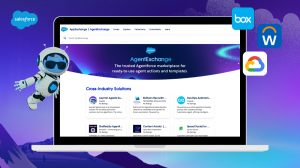How Artificial Intelligence Can Help Us Build a More Human Workplace




Mick Costigan, VP, Salesforce Futures
Editor’s Note: This byline sets up the context for how we get to the kind of plausible, trustable future of AI-human collaboration explored in the second issue of Salesforce Futures Magazine.
Tomorrow’s business leaders won’t run their companies the way they’re run today. They’ll rely on specialized, autonomous AI agents to augment employees. They’ll have AI chiefs of staff that manage teams of these specialized agents. And they’ll use new, AI-powered tools to get closer to their customers and make faster, better decisions. The sum of these new capabilities will have a major impact on the shape of work — both for leaders and employees.
A big shift is coming, and the evidence isn’t just anecdotal. According to the Slack Workforce Index, the number of leaders looking to integrate AI tools into their business has skyrocketed 7x since September 2023. Salesforce research tells us nearly 8 in 10 global workers are open to an autonomous AI future. These changes could happen slower or faster than experts anticipate, but we feel confident that, in the near future, work won’t look like it does today.
According to the Slack Workforce Index, the number of leaders looking to integrate AI tools into their business has skyrocketed 7x since September 2023.
Mick Costigan, VP, Salesforce Futures
Still, despite all of the hype and excitement around technological possibilities, AI leaders have yet to present a cohesive, plausible, and optimistic vision of an AI-powered workplace that serves the needs of humans and customers. What might such a vision look like?
Thinking beyond tech and narrow applications to existing workflows
In the [still] early phases of a major technology shift, we tend to over-focus on the application of technology innovations to existing workflows. Such advances are important, but closing the imagination gap about the possible new shapes of work requires us to consider more than just technology. It requires us to think about people, both as the customers who react to new offerings and as the employees who are responsible for delivering them. Some will eagerly adopt new technology. Others will resist and drag their feet. As they put the technology to use, they’ll uncover new complications the innovators never foresaw and devise novel solutions. And they’ll collaborate with both human colleagues and AI in familiar and unprecedented ways.
Truly insightful futures also require us to go beyond close-in changes to the second-order effects spawned by AI. To take a canonical example, imaginative thinking about the potential effects of building the interstate highway system might have led us to expect we’d see big-box retailers like Walmart popping up along the way as well as longer commutes. Bonus points would go for realizing that, with more people stuck in traffic jams than ever before, a new captive audience for offerings like talk radio was being created.
In our first issue, Personal AI, we created “speculative futures” that imagined the impacts of different types of personal AI agents at scale. We envisaged a state-sponsored AI agent, a premium, hyper-personalized agent subscription service, and a new marketplace of highly specialized “indie agents” from upstart providers, among others. These imagined offerings generated the bulk of reactions from our readers as they pushed and pulled on the different futures and debated their likelihood. They also helped us have more strategic conversations with Salesforce leaders and our customers about how the relationships between companies and their customers might change.
Shapes of work
For our new issue, Shapes of Work, we took our speculative AI futures inside the enterprise, imagining three connected companies at different points in their respective AI transformations. We asked what it might really look and feel like for AI-powered companies navigating tomorrow’s business challenges. Because communication is the lifeblood of any organization, we focused our efforts on the internal and external messages, memos, memes, and other “communications artifacts” these companies generate.
One of our imagined companies, Caravan, is an AI-native relocation services company navigating rapid growth. Our second, Walker Homes, is struggling to recover from strategic missteps that have left it unable to deliver the kind of experiences its customers expect. Last, Sandstone Services is a residential and commercial facilities maintenance company that is seeking to drive growth without losing what’s made it so successful with customers in the past.
For a deep dive into these questions and others, check out the magazine, where we “unpack” each future, exploring the rationale behind the stories and the implications for today’s leaders.
Placing these companies in a shared future and thinking through their unique journeys helped our team ask better questions about the challenges companies will encounter in the AI transition. For example, how will small companies, which are heavily dependent on AI, build company cultures that bind employees together with a shared sense of mission? How will collaborators in such an environment build trust and connection? For more established companies, how might agents enable better implementation and alignment around large-scale strategic initiatives? And how will all companies cultivate and maintain customer relationships in a world where personal agents, like those from our first issue, handle most interactions for the consumers they serve?
A more human future of work
Autonomous AI agents have the power to augment human capabilities and unlock creativity and innovation at a much greater scale. But this type of desirable future won’t happen overnight or automatically. Human agency is critical to charting the course to a trusted, autonomous future with AI agents. Innovations like better LLMs, specialized agents, and adaptive interfaces won’t matter if the companies who use them lose sight of what endeared them to customers in the first place and employees don’t find value in embedding them into the flow of work. So, what should we do to mitigate downsides and improve the likelihood of futures we want?
Human agency is critical to charting the course to a trusted, autonomous future with AI agents.
Mick Costigan, VP, Salesforce Futures
We think that absorbing the magazine will equip leaders to have better conversations and shape a future of work they’re excited to work toward. Specifically, we hope they’ll consider — as Salesforce is right now — the choices required to use AI in service of building better relationships with employees, customers, and other stakeholders. And, ultimately, to build an enterprise that’s not just more intelligent, but also more human.
More information
- Read the previous issue of Salesforce Futures Magazine on personal AI and how it’ll change customer relationships
- Learn more about AI adoption trends in the workplace from the Slack Workforce Index
- Uncover new research on workers’ trust in autonomous AI
- Read why trust and training are key to the success of AI agents in organizations















